This page undergo frequent updates.
High Speed Bullet Train
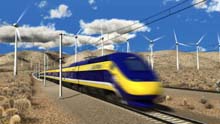
High-speed rail is a type of passenger rail transport that operates
significantly faster than the normal speed of rail traffic. Specific
definitions include 200 km/h (124 mph) and faster — depending on
whether the track is upgraded or new — by the European Union, and above
90 mph (145 km/h) by the United States Federal Railroad Administration,
but there is no single standard, and lower speeds can be required by
local constraints. While high-speed rail is designed for passenger
travel, some high speed systems offer also some kind of freight
service. For instance, the French mail service La Poste owns a few
special TGV trains for carrying postal freight.
Rationale
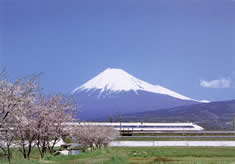
In both Japan and France the initial impetus for the introduction of
high speed rail was the need for additional capacity to meet increasing
demand for passenger rail travel. By the mid-1950s, the Tōkaidō Main
Line in Japan was operating at full capacity, and construction of the
first segment of the Tōkaidō Shinkansen between Tokyo and Osaka started
in 1959. The Tōkaidō Shinkansen opened on October 1, 1964, in time for
the Tokyo Olympics. The situation for the first line in Japan was
different than the subsequent lines. The route was already so densely
populated and rail oriented that highway development would be extremely
costly, and that one single line between Tokyo and Osaka could bring
service to over half the nation's population, in 1959 that was nearly
45 million people, today well over 65 million. The Tokaido Shinkansen
line is the most heavily traveled high speed line in the world, and
still transports more passengers than all other high speed rail lines
in the world combined, including in Japan. The subsequent lines in
Japan had rationale more similar to situations in Europe.
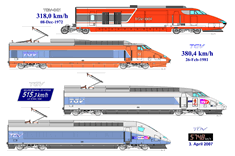
In France the main line between Paris and Lyon was projected to run out of capacity
by 1970, so it was decided to build a new line. In both cases the choice to build
a completely separate passenger-only line allowed for the much straighter higher
speed lines. The dramatically reduced travel times on both lines bringing cities
within three hours of one another caused explosions in ridership. It was the
commercial success of both lines that inspired those countries and their economies
to expand or start high speed rail networks.
In the United States the decades after World War II, improvements in automobiles
and aircraft, severe antitrust restrictions on railroads, and government subsidization
of highways and airports made those means practical for a greater portion of
the population than previously. In Europe and Japan, emphasis was given to rebuilding
the railways after the war. In the United States, emphasis was given to building
a huge national interstate highway system and airports. Urban mass transport
systems in the United States were largely eschewed in favor of road expansion.
The U.S. railways have been less competitive partly because the government has
tended to favour road and air transportation more than in Japan and European
countries, and partly because of lower population density in the United States,
but as energy costs increase, rail ridership is increasing across the country.
Travel by rail becomes more competitive in areas of higher population
density or where gasoline is expensive, because conventional trains are more
fuel efficient than cars . Very few high-speed trains consume diesel or other
fossil fuels but the power stations that provide electric trains with power
can consume fossil fuels. In Japan and France, where the most extensive high
speed rail networks exist, a large proportion of electricity comes from nuclear
power. Even using electricity generated from coal or oil, trains are more fuel
efficient per passenger per kilometer traveled than the typical automobile
because of efficiencies of scale in generator technology. Rail networks, like
highways, require large fixed capital investments and thus require a blend
of high density and government investment to be competitive against existing
capital infrastructure for aircraft and automobiles. Urban density and mass
transit have been key factors in the success of European and Japanese railway
transport, especially
in countries such as the Netherlands, Belgium, Germany, Switzerland, Spain
and France.
Technology
Much of the technology behind high-speed rail is an improved
application of mature standard gauge rail technology using overhead
electrification. By building a new rail infrastructure with 20th
century engineering, including elimination of constrictions such as
roadway at-grade (level) crossings, frequent stops, a succession of
curves and reverse curves, and not sharing the right-of-way with
freight or slower passenger trains, higher speeds (250–320 km/h) are
maintained. Total cost of ownership of HSR systems is generally lower
than the total costs of competing alternatives (new highway or air
capacity). Japanese systems are often more expensive than their
counterparts but more comprehensive because they have their own
dedicated elevated guideway, no traffic crossings, and disaster
monitoring systems. Despite this, the lion's share of the Japanese
system's cost is related to boring tunnels through mountains, as was in
Taiwan. Recent advances in wheeled trains in the last few decades have
pushed the speed limits past 400 km/h, among the advances being tilting
trainsets, aerodynamic designs (to reduce drag, lift, and noise), air
brakes, regenerative braking, stronger engines, dynamic weight
shifting, etc. Some of the advances were to fix problems, like the
Eschede disaster. The record speed for a wheeled electric train is
574.8 km/h is held by a shortened TGV train and long straight highly
modified track. The record speed for an unmodified commercial trainset
is 403.7 km/h, held by the Velaro E. European high-speed routes
typically combine segments on new track, where the train runs at full
commercial speed, with some sections of older track on the extremities
of the route, near cities. In France, the cost of construction (which
was €10 million/km (US$15.1 million/km)
for LGV Est) is minimized by adopting steeper grades rather than
building tunnels
and viaducts. However, in mountainous Switzerland, tunnels are
inevitable. Because
the lines are dedicated to passengers, gradients of 3.5%, rather than
the previous
maximum of 1–1.5% for mixed traffic, are used. Possibly more expensive
land is
acquired in order to build straighter lines which minimize line
construction
as well as operating and maintenance costs. In other countries
high-speed rail
was built without those economies so that the railway can also support
other
traffic, such as freight. Experience has shown however, that trains of
significantly
different speeds cause massive decreases of line capacity. As a result,
mixed-traffic
lines are usually reserved for high-speed passenger trains during the
daytime,
while freight trains go at night. In some cases, nighttime high-speed
trains
are even diverted to lower speed lines in favor of freight
traffic.
Magnetic Levitation Train (Maglev) Transport
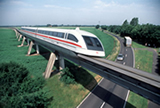
A maglev, or magnetically levitating train is a form of transportation
that suspends, guides and propels vehicles (predominantly trains) using
electromagnetic force. This method has the potential to be faster and
quieter than wheeled mass transit systems, potentially reaching
velocities comparable to turboprop and jet aircraft (900 km/h, 600
mph). The highest recorded speed of a maglev train is 581 km/h (361
mph), achieved in Japan in 2003, 6 km/h faster than the conventional
TGV speed record.
Maglev Commercial operation
The first commercial Maglev
"people-mover" was officially opened in 1984 in Birmingham, England. It
operated on an elevated 600-metre (1,969 ft) section of monorail track
between Birmingham International Airport and Birmingham International
railway station. It ran at 42 km/h (26 mph) until the system was
eventually closed in 1995 due to reliability and design problems. The
best-known high-speed maglev currently operating commercially is the
IOS (initial operating segment) demonstration line of the German built
Transrapid train that can transports people 30 km (18.6 miles) in just
7 minutes 20 seconds, achieving a top velocity of 431 km/h (268 mph),
averaging 250 km/h (150 mph). Other commercially operating lines exist
in Japan, such as the Linimo line. Maglev projects worldwide are being
studied for feasibility. In Japan at the Yamanashi test track, current
maglev train technology is mature, but costs and problems remain a
barrier to development, alternative technologies are being developed to
address those issues.
Maglev Technology
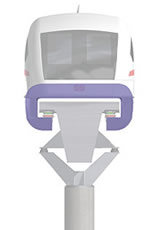
All operational implementations of maglev technology have had minimal
overlap with wheeled train technology and have not been compatible with
conventional rail tracks. Because they cannot share existing
infrastructure, maglevs must be designed as complete transportation
systems. The term "maglev" refers not only to the vehicles, but to the
railway system as well, specifically designed for magnetic levitation
and propulsion. There are two primary types of maglev technology:
 |
Electromagnetic suspension (EMS) uses the attractive magnetic force of a magnet beneath a rail to lift the train up. |
 |
Electrodynamics suspension (EDS) uses a repulsive force between two magnetic fields to push
the train away from the rail. |
 |
Another
experimental technology, which was designed, proven mathematically,
peer reviewed, and patented, but is yet to be built, is the
magnetodynamic suspension (MDS), which uses the attractive magnetic
force of a permanent magnet array near a steel track to lift the train
and hold it in place. |
Electromagnetic Suspension
In current EMS systems, the train levitates above a steel rail while electromagnets,
attached to the train, are oriented toward the rail from below. The electromagnets
use feedback control to maintain a train at a constant distance from the
track, at approximately 15 millimeters (0.6 in).
Electrodynamics Suspension
EDS Maglev Propulsion via propulsion coilsIn Electrodynamics suspension
(EDS), both the rail and the train exert a magnetic field, and the train
is levitated by the repulsive force between these magnetic fields. The
magnetic field in the train is produced by either electromagnets (as in JR-Maglev)
or
by an array of permanent magnets (as in Inductrack). The repulsive force
in the track is created by an induced magnetic field in wires or other
conducting
strips in the track.
At slow speeds, the current induced in these coils and the resultant
magnetic flux is not large enough to support the weight of the train.
For this reason the train must have wheels or some other form of landing
gear to support
the train until it reaches a speed that can sustain levitation.
Propulsion coils on the guideway are used to exert a force on the magnets
in the train and make the train move forward. The propulsion coils that
exert a force on the train are effectively a linear motor: An alternating
current flowing through the coils generates a continuously varying magnetic
field
that
moves forward along the track. The frequency of the alternating current
is synchronized to match the speed of the train. The offset between the
field exerted by magnets on the train and the applied field create a force
moving
the train forward.
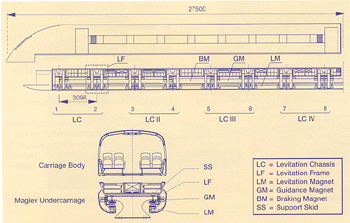
An EMS system can provide both levitation and propulsion using an onboard
linear motor. EDS systems can only levitate the train using the magnets
onboard, not propel it forward. As such, vehicles need some other technology
for propulsion.
A linear motor (propulsion coils) mounted in the track is one solution.
Over long distances where the cost of propulsion coils could be prohibitive,
a propeller
or jet engine could be used.
Stability
Earnshaw's theorem shows that any combination of static magnets cannot
be in a stable equilibrium. However, the various levitation systems achieve
stable levitation by violating the assumptions of Earnshaw's theorem.
Earnshaw's theorem assumes that the magnets are static and unchanging
in field strength
and that permeability is constant everywhere. EMS systems rely on active
electronic stabilization. Such systems constantly measure the bearing
distance and adjust
the electromagnet current accordingly. All EDS systems are moving systems
(no EDS system can levitate the train unless it is in motion).
Because Maglev vehicles essentially fly, stabilization of pitch, roll and yaw
is required by magnetic technology. In addition translations, surge (forward
and backward motions), sway (sideways motion) or heave (up and down motions)
can be problematic with some technologies.
Hydrail - Hydrogen Railway Trains (prior September 2007)
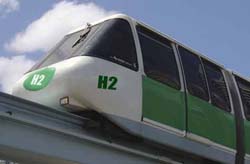
Hydrail is a term used to describe the new breed of hydrogen railway
trains. Much focus has been given lately to hydrogen cars and other
vehicles, but little light has been shown on the emerging hydrail
field. Hydrogen trains pack the promise of clean propulsion, fewer
emissions and less dependency upon fossil fuel (excavation of coal and
oil). One of the most compelling arguments for adopting hydrogen trains
rapidly is that a vast hydrogen distribution network will not have to
be built anywhere near the scale that it will have to be built for
hydrogen cars. The decreased mobility of a train as compared to a car
will be an advantage in delivering hydrogen to just a few key refueling
points along the rail line. Trains don't drive off-road or in
complicated city streets and alleys like cars do, so this is an
inherent advantage of hydrail. It's true that hydrogen trains are not
quite here yet, but the future looks bright. So bright in fact, that
the light you see at the end of the tunnel, may one day just be a
hydrogen train.
Benefits of Hydrogen Trains Trains have been
for generations the main transport for crucial goods. Tracks spanned
the landscape and during WWI and WWII, helped to mobilize nations.
Although the glory days of trains have faded there is a new resurgence
of interest in trains, especially those powered by hydrogen. This
interest is sweeping the world. The potential for hydrogen power is
largely untapped, with only a handful of vehicles and contrivances
currently on the market. Hydrogen trains, or hydrail as some are
calling it, have the potential to provide benefits to the environment
and, once setup, are economical to operate.
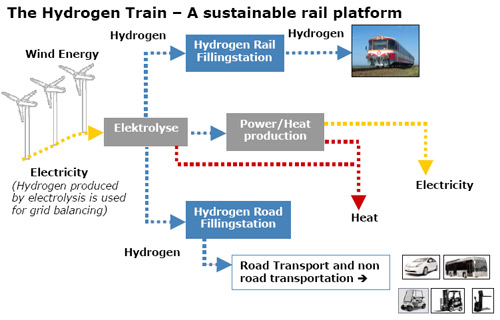 The Hydrogen Train, Hop on Board
The Hydrogen Train, Hop on Board
Farsighted entities from local governments to nations have been
exploring the potential of hydrogen trains. For example, in North
Carolina, there is a campaign to fund and promote the use of hydrogen
trains. The Department of Commerce is sponsoring an initiative to make
the technology accessible and feasible. In Denmark, there is a
full-scale push to establish a working hydrogen train system as part of
their efforts to convert to renewable fuels. The Danes are aggressively
promoting the development of the hydrail system, with an eye on being
the first in Europe to do so. The Railway Technical Research Institute
is also racing ahead with aggressive plans to put a hydrogen fuel cell
train on the tracks by 2010.
Why Not, Indeed? Not only are hydrogen trains more
environmentally friendly than others, the byproduct is water, and there
are other practical reasons to pursue this technology for trains.
 |
Hydrogen is renewable |
 |
Reduces the need for fossil fuels |
 |
Economical |
Hydrogen will allow communities to be independent from foreign fuels.
The ability to manufacture and utilize available resources is practical
on many levels, socially, economically and politically. Socially, there
can be a great sense of pride knowing that that a community is free
from the dependence inherent in fossil fuels, and in knowing that the
community is resourceful and proactive in addressing the eminent issues
of global warming and diminishing resources. Economically, entities
that invest now in the technologies to manufacture and to establish the
infrastructure for hydrogen trains, will realize savings on fuel costs
for generations. Politically, reducing dependence on foreign oil will
go a long way to diminishing the conflict inherent in the manufacture
and distribution of fossil fuels. Also, offering clean air to
constituents is a popular platform for many politicians. The first
hydrogen trains in the hydrail industry have been used successfully in
mining operations. Since hydrail wouldn't need a vast hydrogen
infrastructure built around it as is required of the automotive
industry, hydrogen-powered trains make sense. Japan is also moving
forward in building and promoting commuter hydrogen trains. Of note is
East Japan Railway (JR East), which has just demonstrated the world's
first commuter hydrogen hybrid train. This train will replace both
diesel and electric trains in the area which travel to remote regions.
The JR East New Energy Train boasts two 65kw PEM fuel cells and two
95kw electric motors. Regenerative braking recharges the lithium-ion
battery pack. JR East has been competing with Tokyo's Railway Technical
Research Institute (RTRI) for bringing Japan's first hydrogen commuter
train to market. The New Energy Train is supposed to go live for
commuters in the second quarter of 2007. Isn't it time you got started
and hopped aboard the hydrogen train? If not now, you'll be hopping
aboard just a few years from now.
Taking it One Step Further - Hydrogen Bullet Train
With
the success of the Japanese Hydrail roll out last year, the first
Hydrail to be constructed and operational in the world, the rush to
redesign and re-engineer high speed 'bullet' train fitted with hydrogen
fuel cell is apparent. The investment needed to stimulate such an
interest, the race towards being the first in the line of innovative
and pioneering product, is to land on receiving a concession award - a
concession award from a regional government to build this Hydrogen
Bullet Train, anywhere in the world. This is where
PROJECT INDONESIA INITIATIVE
is where innovative and pioneering entrepreneurs have the opportunity
to propose their products and/or solutions to make their dreams come
true. The INITIATIVE provide the impetus where new ideas and R&D
products, particularly in the clean, green, renewable and sustainable
solutions, can step out and be able to be introduced into the market
place with the backing and support of the public-private partnership
collaboration of Caedz, LLC and the Indonesian Government. The
INITIATIVE provide businesses and entreprenuers from around the world
access to a large captured market (44 million consumers) to realize
qualified new, innovative and bleeding edge solutions into the real
world, not only the Indonesian market but globally quickly.
Interestingly enough, such a hydrgen operated high speed railway
technology is already available. The INITIATIVE provide the site and
the governmental approval and clearance to deploy, test, construct and
operate an integrated hydrogen operated high speed train system.
 High-speed rail is a type of passenger rail transport that operates
significantly faster than the normal speed of rail traffic. Specific
definitions include 200 km/h (124 mph) and faster — depending on
whether the track is upgraded or new — by the European Union, and above
90 mph (145 km/h) by the United States Federal Railroad Administration,
but there is no single standard, and lower speeds can be required by
local constraints. While high-speed rail is designed for passenger
travel, some high speed systems offer also some kind of freight
service. For instance, the French mail service La Poste owns a few
special TGV trains for carrying postal freight.
High-speed rail is a type of passenger rail transport that operates
significantly faster than the normal speed of rail traffic. Specific
definitions include 200 km/h (124 mph) and faster — depending on
whether the track is upgraded or new — by the European Union, and above
90 mph (145 km/h) by the United States Federal Railroad Administration,
but there is no single standard, and lower speeds can be required by
local constraints. While high-speed rail is designed for passenger
travel, some high speed systems offer also some kind of freight
service. For instance, the French mail service La Poste owns a few
special TGV trains for carrying postal freight.  In both Japan and France the initial impetus for the introduction of
high speed rail was the need for additional capacity to meet increasing
demand for passenger rail travel. By the mid-1950s, the Tōkaidō Main
Line in Japan was operating at full capacity, and construction of the
first segment of the Tōkaidō Shinkansen between Tokyo and Osaka started
in 1959. The Tōkaidō Shinkansen opened on October 1, 1964, in time for
the Tokyo Olympics. The situation for the first line in Japan was
different than the subsequent lines. The route was already so densely
populated and rail oriented that highway development would be extremely
costly, and that one single line between Tokyo and Osaka could bring
service to over half the nation's population, in 1959 that was nearly
45 million people, today well over 65 million. The Tokaido Shinkansen
line is the most heavily traveled high speed line in the world, and
still transports more passengers than all other high speed rail lines
in the world combined, including in Japan. The subsequent lines in
Japan had rationale more similar to situations in Europe.
In both Japan and France the initial impetus for the introduction of
high speed rail was the need for additional capacity to meet increasing
demand for passenger rail travel. By the mid-1950s, the Tōkaidō Main
Line in Japan was operating at full capacity, and construction of the
first segment of the Tōkaidō Shinkansen between Tokyo and Osaka started
in 1959. The Tōkaidō Shinkansen opened on October 1, 1964, in time for
the Tokyo Olympics. The situation for the first line in Japan was
different than the subsequent lines. The route was already so densely
populated and rail oriented that highway development would be extremely
costly, and that one single line between Tokyo and Osaka could bring
service to over half the nation's population, in 1959 that was nearly
45 million people, today well over 65 million. The Tokaido Shinkansen
line is the most heavily traveled high speed line in the world, and
still transports more passengers than all other high speed rail lines
in the world combined, including in Japan. The subsequent lines in
Japan had rationale more similar to situations in Europe.  In France the main line between Paris and Lyon was projected to run out of capacity
by 1970, so it was decided to build a new line. In both cases the choice to build
a completely separate passenger-only line allowed for the much straighter higher
speed lines. The dramatically reduced travel times on both lines bringing cities
within three hours of one another caused explosions in ridership. It was the
commercial success of both lines that inspired those countries and their economies
to expand or start high speed rail networks.
In the United States the decades after World War II, improvements in automobiles
and aircraft, severe antitrust restrictions on railroads, and government subsidization
of highways and airports made those means practical for a greater portion of
the population than previously. In Europe and Japan, emphasis was given to rebuilding
the railways after the war. In the United States, emphasis was given to building
a huge national interstate highway system and airports. Urban mass transport
systems in the United States were largely eschewed in favor of road expansion.
The U.S. railways have been less competitive partly because the government has
tended to favour road and air transportation more than in Japan and European
countries, and partly because of lower population density in the United States,
but as energy costs increase, rail ridership is increasing across the country.
Travel by rail becomes more competitive in areas of higher population
density or where gasoline is expensive, because conventional trains are more
fuel efficient than cars . Very few high-speed trains consume diesel or other
fossil fuels but the power stations that provide electric trains with power
can consume fossil fuels. In Japan and France, where the most extensive high
speed rail networks exist, a large proportion of electricity comes from nuclear
power. Even using electricity generated from coal or oil, trains are more fuel
efficient per passenger per kilometer traveled than the typical automobile
because of efficiencies of scale in generator technology. Rail networks, like
highways, require large fixed capital investments and thus require a blend
of high density and government investment to be competitive against existing
capital infrastructure for aircraft and automobiles. Urban density and mass
transit have been key factors in the success of European and Japanese railway
transport, especially
in countries such as the Netherlands, Belgium, Germany, Switzerland, Spain
and France.
In France the main line between Paris and Lyon was projected to run out of capacity
by 1970, so it was decided to build a new line. In both cases the choice to build
a completely separate passenger-only line allowed for the much straighter higher
speed lines. The dramatically reduced travel times on both lines bringing cities
within three hours of one another caused explosions in ridership. It was the
commercial success of both lines that inspired those countries and their economies
to expand or start high speed rail networks.
In the United States the decades after World War II, improvements in automobiles
and aircraft, severe antitrust restrictions on railroads, and government subsidization
of highways and airports made those means practical for a greater portion of
the population than previously. In Europe and Japan, emphasis was given to rebuilding
the railways after the war. In the United States, emphasis was given to building
a huge national interstate highway system and airports. Urban mass transport
systems in the United States were largely eschewed in favor of road expansion.
The U.S. railways have been less competitive partly because the government has
tended to favour road and air transportation more than in Japan and European
countries, and partly because of lower population density in the United States,
but as energy costs increase, rail ridership is increasing across the country.
Travel by rail becomes more competitive in areas of higher population
density or where gasoline is expensive, because conventional trains are more
fuel efficient than cars . Very few high-speed trains consume diesel or other
fossil fuels but the power stations that provide electric trains with power
can consume fossil fuels. In Japan and France, where the most extensive high
speed rail networks exist, a large proportion of electricity comes from nuclear
power. Even using electricity generated from coal or oil, trains are more fuel
efficient per passenger per kilometer traveled than the typical automobile
because of efficiencies of scale in generator technology. Rail networks, like
highways, require large fixed capital investments and thus require a blend
of high density and government investment to be competitive against existing
capital infrastructure for aircraft and automobiles. Urban density and mass
transit have been key factors in the success of European and Japanese railway
transport, especially
in countries such as the Netherlands, Belgium, Germany, Switzerland, Spain
and France.
 A maglev, or magnetically levitating train is a form of transportation
that suspends, guides and propels vehicles (predominantly trains) using
electromagnetic force. This method has the potential to be faster and
quieter than wheeled mass transit systems, potentially reaching
velocities comparable to turboprop and jet aircraft (900 km/h, 600
mph). The highest recorded speed of a maglev train is 581 km/h (361
mph), achieved in Japan in 2003, 6 km/h faster than the conventional
TGV speed record.
A maglev, or magnetically levitating train is a form of transportation
that suspends, guides and propels vehicles (predominantly trains) using
electromagnetic force. This method has the potential to be faster and
quieter than wheeled mass transit systems, potentially reaching
velocities comparable to turboprop and jet aircraft (900 km/h, 600
mph). The highest recorded speed of a maglev train is 581 km/h (361
mph), achieved in Japan in 2003, 6 km/h faster than the conventional
TGV speed record.  All operational implementations of maglev technology have had minimal
overlap with wheeled train technology and have not been compatible with
conventional rail tracks. Because they cannot share existing
infrastructure, maglevs must be designed as complete transportation
systems. The term "maglev" refers not only to the vehicles, but to the
railway system as well, specifically designed for magnetic levitation
and propulsion. There are two primary types of maglev technology:
All operational implementations of maglev technology have had minimal
overlap with wheeled train technology and have not been compatible with
conventional rail tracks. Because they cannot share existing
infrastructure, maglevs must be designed as complete transportation
systems. The term "maglev" refers not only to the vehicles, but to the
railway system as well, specifically designed for magnetic levitation
and propulsion. There are two primary types of maglev technology: 
 Hydrail is a term used to describe the new breed of hydrogen railway
trains. Much focus has been given lately to hydrogen cars and other
vehicles, but little light has been shown on the emerging hydrail
field. Hydrogen trains pack the promise of clean propulsion, fewer
emissions and less dependency upon fossil fuel (excavation of coal and
oil). One of the most compelling arguments for adopting hydrogen trains
rapidly is that a vast hydrogen distribution network will not have to
be built anywhere near the scale that it will have to be built for
hydrogen cars. The decreased mobility of a train as compared to a car
will be an advantage in delivering hydrogen to just a few key refueling
points along the rail line. Trains don't drive off-road or in
complicated city streets and alleys like cars do, so this is an
inherent advantage of hydrail. It's true that hydrogen trains are not
quite here yet, but the future looks bright. So bright in fact, that
the light you see at the end of the tunnel, may one day just be a
hydrogen train. Benefits of Hydrogen Trains Trains have been
for generations the main transport for crucial goods. Tracks spanned
the landscape and during WWI and WWII, helped to mobilize nations.
Although the glory days of trains have faded there is a new resurgence
of interest in trains, especially those powered by hydrogen. This
interest is sweeping the world. The potential for hydrogen power is
largely untapped, with only a handful of vehicles and contrivances
currently on the market. Hydrogen trains, or hydrail as some are
calling it, have the potential to provide benefits to the environment
and, once setup, are economical to operate.
Hydrail is a term used to describe the new breed of hydrogen railway
trains. Much focus has been given lately to hydrogen cars and other
vehicles, but little light has been shown on the emerging hydrail
field. Hydrogen trains pack the promise of clean propulsion, fewer
emissions and less dependency upon fossil fuel (excavation of coal and
oil). One of the most compelling arguments for adopting hydrogen trains
rapidly is that a vast hydrogen distribution network will not have to
be built anywhere near the scale that it will have to be built for
hydrogen cars. The decreased mobility of a train as compared to a car
will be an advantage in delivering hydrogen to just a few key refueling
points along the rail line. Trains don't drive off-road or in
complicated city streets and alleys like cars do, so this is an
inherent advantage of hydrail. It's true that hydrogen trains are not
quite here yet, but the future looks bright. So bright in fact, that
the light you see at the end of the tunnel, may one day just be a
hydrogen train. Benefits of Hydrogen Trains Trains have been
for generations the main transport for crucial goods. Tracks spanned
the landscape and during WWI and WWII, helped to mobilize nations.
Although the glory days of trains have faded there is a new resurgence
of interest in trains, especially those powered by hydrogen. This
interest is sweeping the world. The potential for hydrogen power is
largely untapped, with only a handful of vehicles and contrivances
currently on the market. Hydrogen trains, or hydrail as some are
calling it, have the potential to provide benefits to the environment
and, once setup, are economical to operate.  The Hydrogen Train, Hop on Board
Farsighted entities from local governments to nations have been
exploring the potential of hydrogen trains. For example, in North
Carolina, there is a campaign to fund and promote the use of hydrogen
trains. The Department of Commerce is sponsoring an initiative to make
the technology accessible and feasible. In Denmark, there is a
full-scale push to establish a working hydrogen train system as part of
their efforts to convert to renewable fuels. The Danes are aggressively
promoting the development of the hydrail system, with an eye on being
the first in Europe to do so. The Railway Technical Research Institute
is also racing ahead with aggressive plans to put a hydrogen fuel cell
train on the tracks by 2010. Why Not, Indeed? Not only are hydrogen trains more
environmentally friendly than others, the byproduct is water, and there
are other practical reasons to pursue this technology for trains.
The Hydrogen Train, Hop on Board
Farsighted entities from local governments to nations have been
exploring the potential of hydrogen trains. For example, in North
Carolina, there is a campaign to fund and promote the use of hydrogen
trains. The Department of Commerce is sponsoring an initiative to make
the technology accessible and feasible. In Denmark, there is a
full-scale push to establish a working hydrogen train system as part of
their efforts to convert to renewable fuels. The Danes are aggressively
promoting the development of the hydrail system, with an eye on being
the first in Europe to do so. The Railway Technical Research Institute
is also racing ahead with aggressive plans to put a hydrogen fuel cell
train on the tracks by 2010. Why Not, Indeed? Not only are hydrogen trains more
environmentally friendly than others, the byproduct is water, and there
are other practical reasons to pursue this technology for trains. 